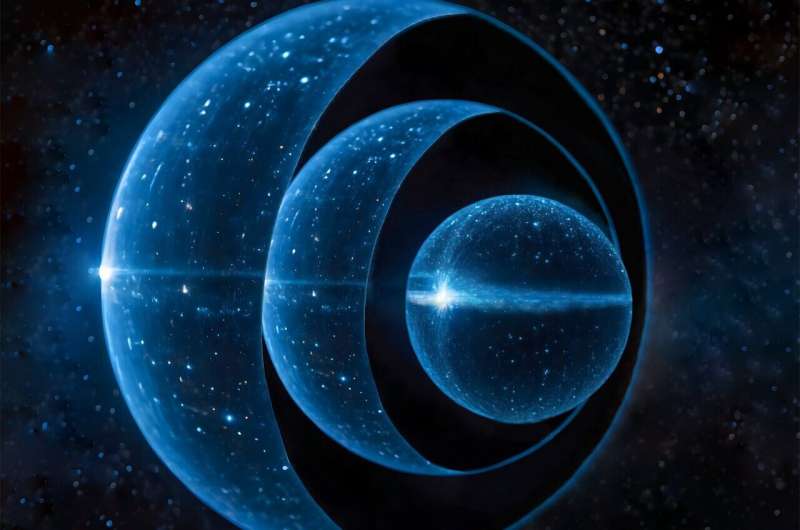February 17, 2024 report
This article has been reviewed according to Science X's editorial process and policies. Editors have highlighted the following attributes while ensuring the content's credibility:
fact-checked
trusted source
proofread
Saturday Citations: Einstein revisited (again); Atlantic geological predictions; how the brain handles echoes

Einstein's inexhaustible field equations just keep on predicting weird stellar objects, and the latest one is a doozy—so strap on your helmet, inside of which is another helmet, encasing still yet another helmet. This headgear is modeled on a weird solution to the field equations described below, along with an interesting neural study involving human speech in reverberant environments and predictions for the Atlantic Ocean over the next 20-odd-million years.
Specimen ordinary
We all want to find soft-tissue dinosaur remains. Like, if losing the permafrost is absolutely necessary to benefit the fossil fuel industry, at least we should get a whole frozen triceratops out of it, right? In 1931, diggers in the Italian Alps uncovered a fossil imprint of a Tridentinosaurus antiquus; within its body outline is dark material that was long interpreted as a fossilized imprint of skin remains.
But researchers at the University of Cork recently conducted the first detailed analysis of the fossil and arrived at the disappointing, wet-blanket conclusion that the dark material is a painted coating. Using varnish or lacquers to preserve fossilized specimens was common practice in the past. However, the analysis also revealed osteoderms, tiny bony scales, on the specimen's back.
Object unusual
In 1916, German physicist Karl Schwarzchild proposed a solution to Einstein's equations of general relativity so outrageous that Albert Einstein locked his doors and called the police: that a black hole contained a singularity so gravitationally dense that it punched right through space-time like the Kool-Aid man. The physics field erupted in disbelief. Einstein sought to use his own equations to prove black holes were impossible.
But eventually, things calmed down, and physicists turned their attention to designing big bombs and wearing wide-brimmed hats. In 2001, physicists Pawel Mazur and Emil Mottola published another solution to Einstein's equations proposing a new object: gravitational condensate stars, or gravastars.
Gravastars are as heavy as black holes and exert similar gravity; however, they do not have an event horizon or a singularity. The interior of a gravastar comprises exotic energy that exerts negative pressure against the gravitational forces compressing the object, and its surface is a vanishingly thin skin of ordinary matter.
Now, two physicists from Goethe University Frankfurt have proposed another solution to the field equations that describes a gravastar inside another gravastar—they call it a "nestar," and say it's like a Russian matryoshka doll. Their solution allows for a series of nested gravastars because each successive gravastar is in self-gravitating equilibrium.
The authors write, "Although these ultra-compact objects are admittedly very exotic, some of the solutions found provide an interesting alternative to a black hole by having a singularity-free origin, a full matter interior, a time-like matter surface, and a compactness C→(1/2)-."
Mantle hungry
What are you doing 20 million years from now? It may be possible to visit the Atlantic Rim by then if you're not afraid of all the earthquakes along the East Coast. Using computer modeling, researchers at the University of Lisbon predict that the subduction zone under the Gibraltar Strait will eventually develop into an Atlantic subduction system like the "ring of fire" around the Pacific Ocean.
Their model relies not on the formation of a new subduction system, which requires breaking tectonic plates—they're way too hard to break without, I don't know, smashing them with a giant asteroid—but instead on the migration of the Gibraltar Strait subduction zone further inside the Atlantic. And then, in geologic terms, the Atlantic will "close" and begin to die, much as the Mediterranean Sea is in the gasping process of doing.
Notably, the study, which relies on supercomputer processing, would have been impossible a handful of years ago. The Gibraltar subduction zone has been in a dormant period for about 1 million years, but when it wakes up, according to the model, it will migrate and eat breakfast (the oceanic lithosphere), a process of recycling the crust under the eastern Atlantic into the Earth's mantle.
Reverberations eradicated
Humans are super-great at distinguishing speech from its own echoes in environments like canyons and parking garages, even though the echoes distort the sound of the original speech. And if you want to train an AI system to separate speech from its own echoes, you learn from the master: the goopy human brain. Researchers from Zhejiang University conducted a study using magnetoencephalography to record human neural activity while study volunteers listened to a story with and without an echo.
They compared those neural signals to computational models that either simulate the brain adapting to the echo or separating the echo from the original speech. The neural adaptation simulation did not fully capture the observed brain responses; however, the simulation of speech/echo separation closely matched the brain activity of the study participants.
The results suggest that "auditory stream segregation" accounts for human abilities like singling out a specific speaker's words in a noisy environment like a restaurant, as well as distinguishing speech in a reverberant space.
© 2024 Science X Network





















